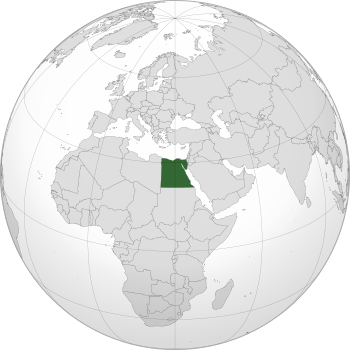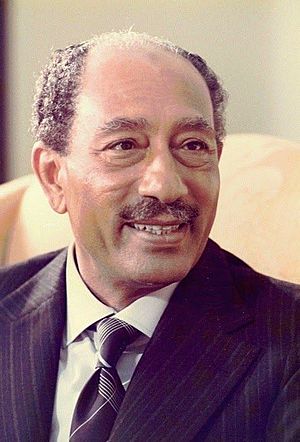History of Egypt under Anwar Sadat facts for kids
Anwar Sadat became the President of Egypt on October 15, 1970. This was after the death of the previous president, Gamal Abdel Nasser. Sadat was president for eleven years until he was assassinated on October 6, 1981.
Even though Sadat seemed to follow Nasser's ideas at first, he soon made big changes. He changed Egypt's economy and politics. He also ended Egypt's close friendship with the Soviet Union. Instead, he started working closely with the United States. Sadat also began peace talks with Israel to get back Egyptian land. He allowed more political parties in Egypt, which was a new step. However, during his time, there was more government corruption. The gap between rich and poor also grew wider.
On October 6, 1973, Egypt and Syria started a war against Israel. This war is known as the October War or Yom Kippur War. Their goal was to take back land Israel had occupied since 1967. Egyptian and Syrian forces attacked by surprise. They crossed into the Sinai Peninsula and Golan Heights. They had great success at the start of the war. Later, Israel fought back strongly. The war ended with a ceasefire. Egypt got some land back in Sinai. Sadat was seen as a hero for restoring Egyptian pride.
Later, Sadat and Israeli Prime Minister Menachem Begin signed a peace treaty. This happened after talks led by U.S. President Jimmy Carter. Egypt officially recognized Israel. In return, Israel gave back all of Egypt's Sinai Peninsula. Other Arab leaders did not agree with this peace treaty. They removed Egypt from the Arab League. Many people in Egypt also opposed the treaty. Some groups, especially Islamists, were very angry. This anger led to Sadat's assassination years later.
Contents
Sadat's Early Presidency
After President Nasser passed away, Anwar Sadat became the new president. Many people thought Sadat would be easy to control. But Sadat had his own plans for Egypt. He made smart political moves. He started a "corrective revolution" in May 1971. This removed many of Nasser's strongest supporters from the government.
Sadat also allowed Islamist groups to become more active. Nasser had stopped these groups. Sadat saw them as a way to balance other political ideas. He gave them more freedom in cultural matters.
After a big defeat in the 1967 war, Egypt was fighting a "War of Attrition" with Israel. In 1971, Sadat tried to make peace with Israel. He offered a full peace if Israel returned to its borders from before the war. This peace plan did not work. Neither Israel nor the United States agreed to the terms. Sadat then decided to get more military support. When the Soviet Union refused, he sent their military advisors out of Egypt. He then prepared his army for another fight with Israel.
The Yom Kippur War
In 1971, Sadat signed a friendship treaty with the Soviet Union. But a year later, he told Soviet advisors to leave Egypt. The Soviets did not want Egypt to attack Israel. Sadat wanted another war to get back the Sinai Peninsula. He also wanted to boost Egypt's spirits after the 1967 defeat. He hoped even a small win would change things.
Before the war, Sadat worked hard to get support from other countries. By late 1973, over a hundred countries supported a war. Most Arab League, Non-Aligned Movement, and African Union countries were on his side. Syria agreed to attack Israel with Egypt.
Egypt's army had early successes in the war. They crossed the Suez Canal and advanced into Sinai. But instead of waiting for air support, they pushed deeper. This created a gap in their lines. Israeli tanks, led by Ariel Sharon, used this gap. They entered Egyptian land and reached Suez city. Meanwhile, the United States sent weapons and aid to Israel. In response, Arab oil countries, led by Saudi Arabia, stopped selling oil to the US. This caused an "oil embargo."
The United Nations called for an end to the fighting. Israel later pulled its troops from the west side of the Suez Canal. Arab oil ministers then ended the embargo against the US. For Sadat and many Egyptians, the war was a victory. It brought back Egyptian pride. It also led to peace talks with Israel. These talks eventually helped Egypt get back the entire Sinai Peninsula.
Changes at Home: The Infitah
Quick facts for kids
|
|||||||||
|---|---|---|---|---|---|---|---|---|---|
| 1970–1981 | |||||||||
|
Anthem: “Walla Zaman Ya Selahy” (1970–1979) "Bilady, Bilady, Bilady" (1979–1981)
"بلادي، بلادي، بلادي" (English: "My country, my country, my country") |
|||||||||
 |
|||||||||
| Capital and largest city
|
Cairo | ||||||||
| Official languages | Arabic | ||||||||
| Recognised national languages | Egyptian Arabic | ||||||||
| Religion | Islam | ||||||||
| Demonym(s) | Egyptian | ||||||||
| Government | Unitary one-party semi-presidential Republic (1970–1976) Unitary semi-presidential Republic (1976–1981) |
||||||||
| President | |||||||||
|
• 1970–1981
|
Anwar Sadat | ||||||||
| Vice President | |||||||||
|
• 1970-1971
|
Ali Sabri | ||||||||
|
• 1972-1974
|
Mahmoud Fawzi | ||||||||
|
• 1975-1981
|
Hosni Mubarak | ||||||||
| Prime Minister | |||||||||
|
• 1970–1971 (first)
|
Mahmoud Fawzi | ||||||||
|
• 1980–1981 (last)
|
Anwar Sadat | ||||||||
| Legislature | Parliament | ||||||||
| History | |||||||||
| 28 September 1970 | |||||||||
|
• Sadat Becomes President
|
15 October 1970 | ||||||||
|
• Corrective Revolution
|
15 May 1971 | ||||||||
| 6 October 1973 | |||||||||
| 17 September 1978 | |||||||||
|
• Assassination of Anwar Sadat
|
6 October 1981 | ||||||||
| Area | |||||||||
|
• Total
|
950,408 km2 (366,955 sq mi) | ||||||||
| Population | |||||||||
|
• 1971
|
35,311,910 | ||||||||
|
• 1978
|
41,275,736 | ||||||||
| Currency | Egyptian pound | ||||||||
| ISO 3166 code | EG | ||||||||
|
|||||||||
Sadat used his popularity to make big changes to Egypt's economy. He ended many of the government controls that Nasser had put in place. This new economic plan was called "Infitah," meaning "openness." It allowed more private businesses and encouraged people to invest money.
These changes helped create a wealthy upper class and a small middle class. But they did not help most Egyptians. Many ordinary people became unhappy with Sadat's rule. In 1977, the government tried to stop giving money to keep food prices low. This led to huge protests called the "Bread Riots." Critics said Infitah caused high prices and corruption.
During Sadat's time, many Egyptians also started working abroad. Millions of workers, like builders and electricians, moved to the Persian Gulf region. The money they sent home helped their families buy things like refrigerators, TVs, and cars.
Sadat also brought back some legal protections. He made torture illegal. He put former government officials on trial for bad actions during Nasser's time. Sadat tried to make politics more open but later stopped this effort. In his last years, Egypt faced unrest and tensions between different groups. There were also more arrests without trial.
Peace with Israel: The Camp David Accords
In foreign policy, Sadat also made big changes. He moved Egypt from fighting Israel to seeking peace. After some agreements in 1974 and 1975, Sadat made a bold move. He visited Jerusalem in November 1977. This was a huge step towards peace.
This visit led to an invitation from U.S. President Jimmy Carter. He invited Sadat and Israeli Prime Minister Menachem Begin to talks at Camp David. The result was the famous Camp David Accords. Egypt and Israel signed these agreements on September 17, 1978.
These accords led to the Egypt-Israel peace treaty in March 1979. Through this treaty, Egypt got back control of the Sinai Peninsula. Relations between the U.S. and Egypt also got much better. Egypt became one of the biggest receivers of U.S. foreign aid.
However, Sadat's peace with Israel angered most other Arab countries. Egypt was suspended from the Arab League. In 1977, Egypt also fought a short border war with Libya.
Rise of Religious Influence
After Egypt's defeat in the 1967 war, President Nasser called for religion to play a bigger role. This idea was very popular. By the 1970s, religious feeling grew strong in Egypt and other Muslim countries. More men grew beards, and more women wore the hijab. Religious shows appeared on TV and radio. Islamic speakers became popular. Books praising Islam also became common.
This religious growth led to more people praying. More local mosques were built. However, it also caused some problems with Egypt's Christian minority, the Copts. Some Islamists criticized Muslims for celebrating the spring holiday Sham el-Nessim. They saw it as going against Islam.
Many people believe this religious growth happened for several reasons. The 1967 defeat made people lose faith in Arab nationalism. The 1973 war, with its religious battle cry "Allahu Akbar," was seen as a victory. Also, Saudi Arabia's strict Wahhabism spread. This was helped by money from oil sales after the 1973 oil crisis.
Islamist Groups and Sadat
Sadat also changed how the government treated Islamist groups. He allowed the Muslim Brotherhood to publish a magazine. He closed prisons where Islamists were held. He slowly released imprisoned Muslim Brothers. However, the group itself remained illegal.
Sadat saw Islamists as a useful group to counter his opponents. These opponents included Marxist and Arab leftist student groups. From 1973 to 1979, an Islamist group called Al-Gama'a al-Islamiyya grew strong. They gained control of universities, sometimes with Sadat's help.
In the late 1970s, Sadat started calling himself "The Believer President." He ordered state TV to show the call to prayer five times a day. He also increased religious TV programs. Local officials banned alcohol sales in many areas, except for tourists.
However, Islamists eventually disagreed with Sadat. They did not like his support for women's rights. They also strongly opposed his peace treaty with Israel. By the late 1970s, the government turned against Islamist groups. In June 1981, after some violence, Al-Gama'a al-Islamiyya was shut down. Its leaders were arrested.
A radical Islamist group called Egyptian Islamic Jihad was planning to overthrow the government. They were recruiting military officers and gathering weapons. Their plan was to kill the country's leaders and start a popular uprising.
In February 1981, authorities learned about this plan. In September, Sadat ordered the arrest of over 1,500 people. This included many Jihad members, but also religious leaders and activists. All non-government newspapers were banned. However, the arrests missed a Jihad group in the military. This group, led by Lieutenant Khalid Islambouli, assassinated Anwar Sadat in October.
After Sadat's death, his Vice President, Hosni Mubarak, became the new president.
See also
- History of Egypt under Gamal Abdel Nasser
- History of Egypt under Hosni Mubarak
- Infitah
- Assassination of Anwar Sadat
- Egyptian Revolutionary Command Council
- History of modern Egypt
- List of modern conflicts in the Middle East







